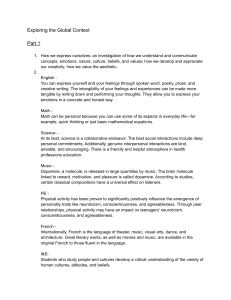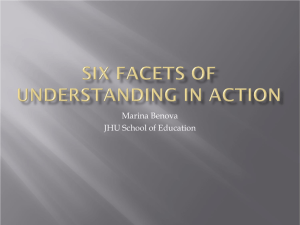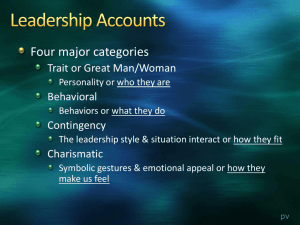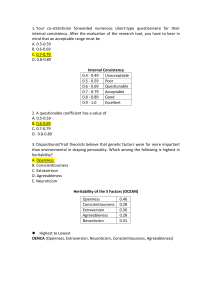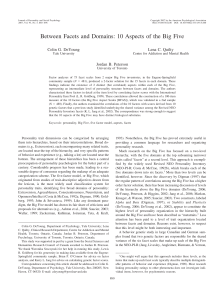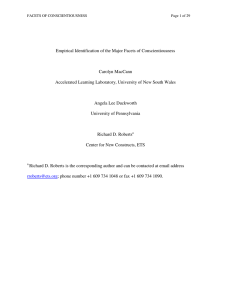Traits, Five Factor Model • Based on lexical approach
advertisement
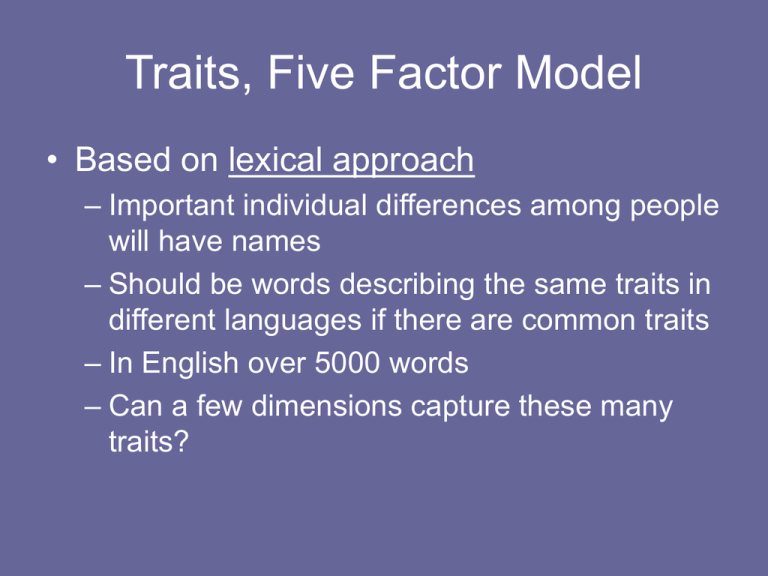
Traits, Five Factor Model • Based on lexical approach – Important individual differences among people will have names – Should be words describing the same traits in different languages if there are common traits – In English over 5000 words – Can a few dimensions capture these many traits? Factor analysis • Statistical tool used to reduce large amounts of data to smaller underlying dimensions • Looks at patterns of co-variation • Method is important because it impacts findings Factor analysis method 1. Collect measurements 2. Compute correlations – matrix 3. Factor extraction (reduce to underlying dimensions) 4. Compute factor loadings 5. Name the factors Example: How people cope with stress • How much did you do ______ during your most recent stressful event? Or rate each item: • 1. Took action quickly, before things could get out of hand. • 2. Refused to believe it was real. • 3. Did something concrete to make the situation better. • 4. Tried to convince myself that it wasn=t happening. • 5. Went on thinking that things were just like they were. • 6. Changed or grew as a person in a new way. • 7. Tried to look at the bright side. Hypothetical correlation matrix Item 1 2 3 4 5 6 7 1 .1 .75 -.05 .03 .12 0 * -.19 .52 .61 -.07 -.08 * .17 0 .11 .08 * .71 .09 .04 * .16 .09 * .59 2 3 4 5 6 7 * * Hypothetical Factor Loadings Factor A B C Item 1 .62 .15 .01 Item 2 .03 -.08 .49 Item 3 .54 .04 -.20 Item 4 .10 .11 .56 Item 5 .07 .08 .45 Item 6 -.02 .66 .12 Item 7 .22 .48 .06 Implications • Garbage in, garbage out • Missing info. may mean missing factors E.g. Escape: smoking, drinking, eating, daydreaming about vacation, etc. • Importance of names of factors Big Five/Five-Factor Model • • Emerging consensus that 5 dimensions capture important pieces of personality Based on: 1. Diverse samples of data 2. Different measures 3. Multiple cultures and languages • Still some disagreement about What the factors are Big Five (Costa & McCrae) • • Five basic dimensions that are very broad 6 facets within each dimension (which are more specific 1. 2. 3. 4. 5. Neuroticism Extraversion Openness to Experience Agreeableness Conscientiousness Neuroticism • Tendency to experience negative (unpleasant) feelings • Emotionally reactive, intense • On other end: calm, emotionally stable, free from persistent negative feelings Neuroticism Facets Anxiety – sense of danger or threat 1. • 2. 3. Tense, jittery, nervous …calm, fearless Anger Depression – feel sad, dejected, low • Lack energey, feel dejected….free from depressive feelings Self-consciousness – sensitive to what others think of them 4. • feel uncomfortable around others, easily embarrassed….don’t feel discomfort in social situations, don’t fear being judged by others Immoderation – strong cravings and urges that are hard to resist Vulnerability – susceptibility to stress 5. 6. • Feel panic, helpless under pressure….feel poised, confident under pressure Extraversion • Enjoy being with others • High energy • Tendency to experience positive emotions • Low scorers: – Quiet, less engaged in social world – NOT shyness or depression Extraversion Facets 1. 2. 3. 4. 5. 6. Friendliness • like others and easily reach out to other people…distant and reserved Gregariousness • Enjoy being around others, like crowds…need more privacy and time to self, dislike crowds Assertievness • Like to speak out, take charge, leaders…let others control group direction Activity Level • Much action, energetic, quick…slower paced, less activity Excitement-Seeking • Easily bored, seek thrills…unlikely to take risks, adverse to thrillseeking Cheerfulness • High on positive emotions such as happiness, optimism, enthusiasm, and joy…low scores don’t’ experience as much joy (but NOT depressed) Openness To Experience • Most disagreement about what this factor is and what to call it. • Imaginative, intellectually curious, sensitive to aesthetics and feelings …. Down to earth, practical,conventional • Not a measure of intelligence Openness Facets 1. Imagination • 2. Artistic Interests • 3. Like new activities, experience different things…prefer familiar things Intellect • 6. Awareness of and expression of feelings…less aware and expressive Adventurousness • 5. Love beauty, aesthetics…not interested in arts Emotionality • 4. Fantasy…fact Like to play with ideas…prefer concrete things over ideas Liberalism • Challenge authority and convention…prefer conventional approaches Conscientiousness • Deliberate in actions, controlled, planful • Low: impulsive Conscientiousness Facets 1. 2. 3. 4. 5. 6. Self-efficacy Orderliness Dutifulness Achievement Striving Self-discipline Cautiousness Agreeableness • Social harmony, ability to get along with others • Low: mistrustful of others, difficulty getting along with others Agreeableness Facets 1. 2. 3. 4. 5. 6. Trust Morality Altruism Cooperation Modesty Sympathy Integration with other trait theories 1. Eysenck’s theory: 2. Similar structure to Eysenck 3. Cattell’s 16 PF scales map on Longitudinal Stability 1. Good evidence for stability over long periods in adulthood 2. Small but sign. age effects: • • • • Older adults lower on N, E, and O Older adults higher on C and A Cohort effect? Some occur across cultures: C increases with age 3. Temperamental characteristics develop into E and N
